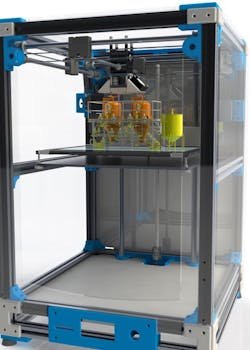It might be a hard pill to swallow for the OEMs and automation suppliers that support the pharmaceutical industry, but medicine may be getting a major manufacturing makeover.
According to a new paper published in the journal of Science, researchers from the University of Glasgow’s School of Chemistry have identified a new method of manufacturing that uses a chemical digital code and 3D printers to create drugs on demand.
The scientists behind the discovery believe this new approach will redefine the portable factory model—something the industry has been diligently working toward. In the Automation World article "The New Pharma Factory" we outlined some initiatives that use a self-contained transportable pod that can be shipped to a location and quickly brought online with modules that support continuous processing under the good manufacturing practice (GMP) guidelines.
A major goal of the initiatives currently underway is to be able to swiftly set up a manufacturing cell anywhere in the world to produce much-needed vaccines, for example. The 3D printer method could be used for the same thing—and much more, the scientists claim.
This could help pave the way for the local manufacturing of drugs outside of specialist facilities, according to Professor Lee Cronin, the University of Glasgow’s Regius Chair of Chemistry, who, with his team, designed and developed the technology. “This approach is a key step in the digitization of chemistry, and will allow the on-demand production of chemicals and drugs that are in short supply, hard to make at big facilities, and [that] allow customization to tailor them to the application,” he said.
The digital code is used by a 3D printer to produce a portable factory, which can be used to make the drug by adding the chemicals in a pre-defined fail-safe sequence. The researchers claim that this approach could dramatically increase the availability of useful drugs regardless of patent life, as they will no longer need to be made in a limited number of dedicated manufacturing facilities. In addition, the ability to ‘print’ drugs on demand could reduce cost, increase the choice available to clinicians, reduce the risk of counterfeiting and help personalize drug delivery to the needs of individual patients.
In the paper, the team of researchers from the University’s School of Chemistry demonstrate the potential of the system by producing the pharmaceutical Baclofen, a muscle relaxer used to treat symptoms caused by multiple sclerosis, including muscle spasms, pain and stiffness.
The team’s factories are designed using a chemical-to-digital convertor to digitize the process so that it can easily be reproduced in a 3D printer. The researchers liken this digital process to converting a compact disc to an MP3 file which can then be listened to on any computer or portable music player. With the addition of an instruction manual, the drug can be produced when and where it is needed.
The question is: Will the pharmaceutical industry adopt such a practice? I’d say it’s certainly a real possibility. The manufacturing industry as a whole is undergoing a digital transformation. We are seeing car parts being 3D printed. Manufacturers and OEMs are using 3D printers to make replacement parts for machines. Consumer goods companies are using additive manufacturing to make household items, like faucets. And, scientists are making human organs with 3D printers. Why not drugs? In fact, it’s already happened.
Back in 2015, the FDA approved the first 3D printed drug, Spritam from Aprecia Pharmaceuticals, which is used for treatment of seizures for people with epilepsy. Made with Aprecia’s proprietary ZipDose technology, the 3D printer stitches together multiple layers of powdered medication. The pill, more porous in nature, is designed to dissolve rapidly—almost instantaneously—helping patients with problems swallowing.
Similarly, Cronin sees his team’s successful production of Baclofen from a 3D printing benchtop device as a proof point that the industry can make complex molecules, such as active pharmaceutical ingredients (APIs), on demand in non-traditional manufacturing environments. The manufacturing scenarios range from printing drugs in hospitals, doctors’ offices, in outer space or in your own home. Of course, there are still regulatory hurdles related to quality control—and much more. But, the fact is, it can be done. And there are many more applications on the horizon.
“We will also use this approach to make a ‘Spotify for chemistry,’ allowing scientists to develop better code to make important chemicals,”Cronin said.
Watch Lee Cronin’s 2012 TED Talk on the real possibility that we could print our own medicine in the future:
Leaders relevant to this article:

